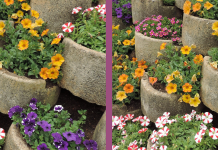Bees are attracted to roses for their pollen but by the time a full-petalled rose opens, the pollen is old and the bees ignore it, says rose grower Ludwig Taschner.
But with single and semi-double roses that have more open blooms and exposed stamens, the pollen is fresh and the bees love it.
Because all modern roses have a long flowering season and are repeat flowering there are always flowers for the bees. Ludwig’s advice is to plant enough roses close together so that bees don’t use up their energy hunting for pollen.
If you don’t have space, plant climbing or willowy shrub roses against a trellis on walls or use the rose-covered trellis as a flowering wall.

Single roses with five petals have their very own charm. The best known single rose is ‘Dainty Bess’, which produces clusters of pink blooms. It was introduced in 1925, so is not far away from its centenary, yet is still a wonderful garden performer.
There are many single floribundas, the best known is ‘Johannesburg Garden Club’, a neat shrub, growing about 1.1m high, covered with delicate soft coral coloured blooms. A gardener’s favourite, it produces an abundance blooms. Use in pots, or in landscapes. A mutation (sport) of that rose is ‘Duncan’s Rose’ with deep pink single blooms.

‘Yellow Butterfly’ is another favourite because the blooms look like a flock of butterflies on the bush. It is a neat little shrub, producing wave upon wave of blooms into winter. Excels in a container, as a hedge or massed in huge landscape projects. Grows about 0.8m high.
Although single blooms do not last quite as long as full petalled flowers they are replaced much quicker and always have a fresh look.
To create a romantic effect with single roses, Ludwig suggests planting them with other flowers in large beds or borders.
Best for containers

Compact growers like ‘Bravo Babylon Eyes’ (picture), ‘Butterfly Kisses’ and ‘Fortuna’ are superb in large pots or when used as groundcovers. Their ‘novelty’ value is also something to be considered.
What’s exceptional about ‘Babylon Bravo Eyes’ is that the stiff petals that stay firm under hot sun. The blooms change colour as they age, so that at any one time the bush will be covered with blooms in different shades, from light pink to reddish pink.
‘Butterfly Kisses’ is a very healthy, free flowering rose that grows to hip height and attracts both butterflies and bees. It produces large sprays of 25 to 45 single blooms through to winter.
Double duty for bees

It is not just single roses that attract bees and butterflies, says rose grower Ludwig Taschner. Any rose that has exposed stamens and pistels makes it easy for the bees.
These are mostly semi double bush roses ‘Iceberg’ and all its variations. The vibrant ‘Purple Glow’ always has busy bee’s amongst its blooms, as do the soft pink blooms of floribunda ‘Mount Nelson’ . There are also the highly perfumed yellow flowering ‘ Courvoisier’ and ‘Friesia’ as well as ‘Perfumery’.

Climbing and shrub roses
Of the climbing roses, ‘Cocktail’ is a favourite, flowering throughout the season with bright orange-red blooms and a yellow eye.

As a security barrier-hedge, ‘Rosa bracteata Macartney’ (white petals with prominent golden stamens) covers up to 10 square metres, enveloping fences and walls. It flowers from November into May and is superbly disease resistant.
‘Simply Charming’ is a stately chest high shrub that is never without its charming five petalled blooms of a very interesting, dappled pink with prominent stamens in the centre.
For more information visit Ludwig’s Roses
Article and images supplied by Alice Coetzee.






